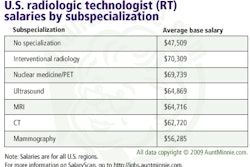A new study finds that radiologists are working longer hours during the week, but they're also enjoying more vacation compared to 14 years ago. These seemingly contradictory findings could be explained by the changing nature of radiology work patterns, according to research to be published in next month's American Journal of Roentgenology.
Jonathan Sunshine and Rebecca Lewis of the Reston, VA-based American College of Radiology (ACR) examined trends in weekly work hours and annual vacation days among full-time U.S. radiologists, finding that the number of mean weekly hours that full-time radiologists worked increased from 1995 to 2007 by a total of five hours, or 10%, overall. But at the same time, vacation hours also increased, yielding a 5% decrease in days worked per year (AJR, October 2009, Volume 193:4, pp. 1136-1140).
Sunshine and Lewis suggest that these seemingly conflicting findings illuminate a shift in work patterns, particularly toward the use of teleradiology services, and can provide key data for radiologists to set their workloads in perspective.
"The total amount of imaging performed in the U.S. has been increasing rapidly ... much more rapidly than any other major type of physician service," they wrote. "The trend in work hours can show how radiologists are coping in the face of this increase."
Work hour and vacation day data can also help illuminate whether there is actually a shortage or a surplus of radiologists, the team suggested. And it can help individual doctors get a more accurate benchmark of their performance, smoothing tension in radiology groups: In the study, Sunshine and Lewis found that many radiologists believe they're working harder than their colleagues. (They're not.)
Academics take the brunt
The study included data from three ACR surveys: one in 1995, the next in 2003, and the final one in 2007.
The 1995 and 2003 surveys asked that participants include nonclinical activities such as administration, teaching, and research in weekly work hours; the surveys also had questions about various types of time away from work, including professional education. The 2007 survey did not list specific nonclinical activities and simply asked participants about vacation. The survey responses were weighted to make them representative of all U.S. radiologists, and data from the 2007 survey were further tested to estimate error that might have been introduced because of the narrowing of survey participants.
The 10% increase in number of mean weekly hours that full-time radiologists worked varied among categories of radiologists, with academics taking the brunt. Academic radiologists saw a mean weekly increase of seven hours compared to 1995, while those in private multispecialty practice and those in private radiology-only practices saw a mean weekly increase of one hour and four hours, respectively.
Vacation results were similar, with academic radiologists enjoying a smaller increase since 1995 in mean vacation days than their colleagues. The group took seven more days per year, whereas those in private radiology-only practices took 16 more days of vacation, and those in private multispecialty practices took 19 more.
Viewing the data from another angle, Sunshine and Lewis found that in 2007, 25% of radiologists (the 25th percentile) worked 45 or fewer hours a week, while 25% (or the 75th percentile) worked 55 hours or more per week. Again, academic radiologists are working harder: the lower 25% worked 48 hours or fewer per week, while the upper 25% worked 58 hours or more per week.
Also in 2007, 25% of radiologists (the 25th percentile) had 25 or fewer vacation days per year, while, at the other end, 25% (the 75th percentile) had 50 or more vacation days per year.
Number of vacation days in 2007, by type of radiologist and percentile group
|
Conflicting findings?
With the 10% mean increase in weekly hours worked between 1995 and 2007 and the mean decrease of 5% of weeks worked annually due to more vacation days, the study showed that the total annual mean increase in hours worked was 5% between 1995 and 2007.
"It seems odd that weekly hours increased while days worked per year decreased," the team wrote. "Given that annual work hours increased, the simple expectation would be that both weekly hours and days worked per year would have increased. The actual opposing trends in weekly hours and days worked per year may reflect the more intense demands for after-hours coverage faced by radiologists over the study period."
Sunshine and Lewis offered a dramatic example to illustrate the point: Teleradiologists may work seven consecutive days, 12 hours per day, and be off-duty for the next week. Their workweek is 84 hours, but they have 26 weeks of vacation per year. This pattern hints at the changing nature of radiology with the rise of new technologies that make teleradiology possible, the team pointed out.
The cost of comparison
In a surprising twist, Sunshine and Lewis discovered that full-time radiologists think they're working more than their fellows -- 10% more, in fact. It's human nature to overestimate positive qualities about oneself, the team suggested. But in this case, the error can cause real, day-to-day problems.
"That most radiologists believe they are working a good deal harder than is typical in their practice may be a serious source of dissatisfaction and friction within the practice, and one not easily overcome," they wrote.
The most critical limitation of the study, the researchers noted, is that the weekly work hours of full-time radiologists may not have been accurately reported, because the data came from individuals rather than objective analyses. But the trends shown are reliable, according to Sunshine and Lewis.
"Together, these two measures [weekly work hours and annual vacation] determine annual work hours, which is probably the best single measure of hours," they wrote.
By Kate Madden Yee
AuntMinnie.com staff writer
September 24, 2009
Related Reading
The Profit Center: Part 7 -- Increase negotiating power by controlling context, September 11, 2009
The Profit Center: Part 5 -- Negotiating your group's stipend, July 31, 2009
The Profit Center: Part 4 -- Creating an 'experience monopoly,' July 3, 2009
RBMA speaker offers keys to managing conflict in radiology groups, June 9, 2009
The Profit Center: Part 3 -- Crafting effective employment contracts, April 24, 2009
Copyright © 2009 AuntMinnie.com



















